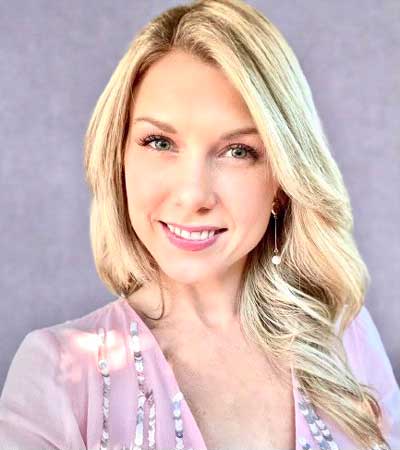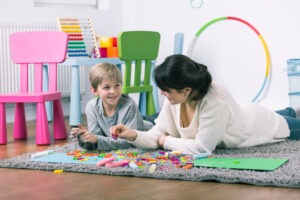The two styles of language acquisition are known as analytic and gestalt. And it can be helpful for parents to know which style their child is using to process language.
Understanding the way a child is building language skills can help parents understand what their child is trying to communicate. It can help parents learn the best ways to support their child’s growing language skills.
What are the 2 Models of Language Development?
Analytic and gestalt are the two ways that children can process and develop language.
Instead of learning the meaning of one word at a time, some children start developing language by memorizing whole phrases (Gestalt language acquisition). They then work backwards into learning the meaning of the words that make up those phrases.
This often displays itself as delayed echolalia. It’s when a child hears a phrase and then echoes (repeats) it later on. Echolalia is often seen in children with Autism. However, some children who are not on the Autism Spectrum also use echolalia.
On your child’s favorite TV show, the main character always says, “let’s go everybody!” before going outside. Your toddler, who’s learning to talk, starts saying “let’s go everybody!” when the two of you leave your house, or as you’re walking out of the grocery store.
Your child might not understand the meaning of each word in that phrase, but he or she memorized it as a chunk.
Analytic vs Gestalt Language Processing
Analytic Language Processing
- “Typical” language acquisition (historically known as this).
- Child learns single words as units first (ex: “go”).
- Progression of language learning moves towards combining words into different phrases and sentences (ex: “I want to go” or “go in”).
Gestalt Language Processing (GLP)
- Begins with the child imitating phrases he or she previously heard (delayed echolalia).
- A child then breaks down the phrase as he or she learns the meaning of the individual words.
- The child uses those individual words to build other, novel phrases and sentences to communicate.
You can think of Analytic language processing as a progression of acquiring language from parts to whole. Whereas Gestalt language processing progresses from whole to individual parts.
Which Method is My Child Using to Learn Language?
The answer could be both!
In general, children typically learn language in an analytic way. They acquire single words, learn the meaning and use of those words, then combine them to form novel phrases.
Research indicates that “even preverbal infants may have the ability to segment words within continuous speech”. This neurological testing has shown that at just 6 months-old, a child may be able to discriminate between individual words within sentences.
In addition to learning language in an analytic method, many children use a form of gestalt language processing known as “echolalia” up until the age of 30 months.
What is "Echolalia"?
Let’s say a child says, “you want a snack?,” to communicate that they are hungry. They’ve likely heard others use the phrase before giving them something to eat. Instead of understanding each individual word to build the phrase, “I want a snack”, they’ve memorized the phrase you used as a whole chunk.
That’s an example of delayed echolalia, a form of gestalt language processing.
There are two types of echolalia; immediate and delayed. Here are the definitions of each form, according to the American Speech-Language Hearing Association (ASHA):
Immediate echolalia: “(Words) that are repeated immediately or after a brief delay.”
Delayed echolalia: “(Words) that are repeated after a significant delay (Prizant & Rydell, 1985). Echolalia is prevalent among individuals with ASD who are verbal and may remain as part of their verbal behavior for some time (Fay, 1969).”
Although some instances of delayed echolalia is a normal part of typical language development, many children with Autism frequently use delayed and immediate echolalia.
Autism Spectrum Disorder is often associated with echolalia and gestalt language processing.
How to Encourage Functional Language
If you hear your child using “chunks of language” or phrases without seeming to understand the meaning of the individual words, he or she may be using gestalt language processing and echolalia.
In the past, echolalia was thought to have no true meaning. So phrases like, “you want some more?” were considered to be simply a child repeating something he or she heard previously.
But with growing research and a movement for the world to become more neurodiversity affirming, we are starting to understand that is not always the case.
Here’s what to know if your child seems to be a gestalt language processor:
- A child may start by repeating memorized phrases (echolalia).
- He or she might not understand what the individual words mean or how to sequence them to build a sentence.
- As the child starts understanding more about how to arrange words to create sentences (“syntax”), they can start breaking down the phrases into single words.
- They can learn how to use those words in a variety of ways and build different types of phrases with them.
If you hear your child using echolalia, here are some key points to keep in mind:
- Remember that the phrase could carry some meaning. (For example, if your child says, “are you thirsty?”, that may be his way of saying, “I am thirsty.”)
- Echoing a question could be a way to say “yes”. (If you ask, “do you want to play bubbles?” and your child imitates, “want to play bubbles?”, that could mean “yes”).
- Help your child break down echolalic phrases to understand what the individual words mean. (use visuals, like pointing or showing your child their shoe as you say, “let’s put on your shoes!”)
Individualized Services
Children who use echolalia and gestalt language processing (GLP) can have difficulty effectively communicating with others.
If you have concerns about your child’s development of language skills, consider seeking an evaluation by a Speech-Language Pathologist.
TherapyWorks offers Speech Therapy, Occupational and Physical Therapy both in-home and through teletherapy. If you would like to learn more, or discuss your child’s specific needs, please don’t hesitate to reach out to TherapyWorks!




